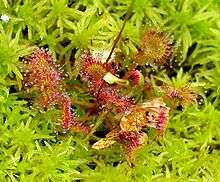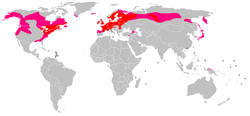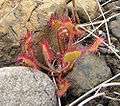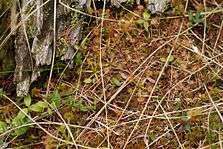Drosera rotundifolia
| Drosera rotundifolia | |
|---|---|
 | |
| Scientific classification | |
| Kingdom: | Plantae |
| (unranked): | Angiosperms |
| (unranked): | Eudicots |
| (unranked): | Core eudicots |
| Order: | Caryophyllales |
| Family: | Droseraceae |
| Genus: | Drosera |
| Species: | D. rotundifolia |
| Binomial name | |
| Drosera rotundifolia L. | |
Drosera rotundifolia — the round-leaved sundew[1] or common sundew — is a species of sundew, a carnivorous plant often found in bogs, marshes and fens. One of the most widespread sundew species, it has a circumboreal distribution, being found in all of northern Europe, much of Siberia, large parts of northern North America, Korea and Japan but is also found as far south as California, Mississippi and Alabama in the United States of America and on New Guinea.
Morphology

The leaves of the common sundew are arranged in a basal rosette. The narrow, hairy, 1.3-to-5.0-centimetre (0.51 to 1.97 in) long petioles support 4-to-10-millimetre (0.16 to 0.39 in) long laminae. The upper surface of the lamina is densely covered with red glandular hairs that secrete a sticky mucilage.
A typical plant has a diameter of around 3 to 5 centimetres (1.2 to 2.0 in), with a 5-to-25-centimetre (2.0 to 9.8 in) tall inflorescence. The flowers grow on one side of a single slender, hairless stalk that emanates from the centre of the leaf rosette. White or pink in colour, the five-petalled flowers produce 1.0-to-1.5-millimetre (0.039 to 0.059 in), light brown, slender, tapered seeds.[2]
In the winter, D. rotundifolia produces a hibernaculum to survive the cold conditions. This consists of a bud of tightly curled leaves at ground level.
Carnivory

The plant feeds on insects, which are attracted to the glistening drops of mucilage, loaded with a sugary substance, covering its leaves. It has evolved this carnivorous behaviour in response to its habitat, which is usually poor in nutrients or is so acidic that nutrient availability is severely decreased. The plant uses enzymes to dissolve the insects – which become stuck to the glandular tentacles – and extract ammonia (from proteins) and other nutrients from their bodies.[3] The ammonia replaces the nitrogen that other plants absorb from the soil, and plants that are placed in a high-nitrogen environment rely less upon nitrogen from captured insects.[4]
It has been assumed that insects were also attracted to the bright red color of the common sundew, but studies using artificial traps have suggested that color does not affect prey attraction.[5]
Distribution

In North America, the common sundew is found in all parts of Canada except the Canadian Prairies and the tundra regions, southern Alaska, the Pacific Northwest, and along the Appalachian Mountains south to Georgia and Louisiana.
It is found in much of Europe, including the British Isles, most of France, the Benelux nations, Germany, Denmark, Switzerland, Czech Republic, Poland, Belarus, the Baltic countries, Sweden and Finland, as well as northern portions of Portugal, Spain, Romania and in Iceland and southern regions of Norway and Greenland. It is infrequent in Austria and Hungary, and some populations are scattered around the Balkans.
In Britain, this is the most common form of sundew and it can be found on Exmoor, Dartmoor, Sedgemoor, the Lake District, Shropshire, Pennines and in Scotland, among other places. It is usually found in bogs, marshes and in hollows or corries on the sides of mountains. It is the county flower of Shropshire.[6]
In Asia, it is found across Siberia and Japan, as well as parts of Turkey, the Caucasus region, the Kamchatka Peninsula and southern parts of Korea. Populations can also be found on the island of New Guinea and Italy.
Habitat

The common sundew thrives in wetlands such as marshes and fens.[7] It is also found in wet stands of black spruce, Sphagnum bogs, silty and boggy shorelines and wet sands. It prefers open, sunny or partly sunny habitats.
Conservation
The round-leaved sundew is classified as Least Concern in the IUCN red list. In North America, it is considered endangered in the US states of Illinois and Iowa, exploitably vulnerable in New York, and threatened in Tennessee.
Cultivation
D. rotundifolia is one of the temperate species of Drosera cultivated by growers interested in carnivorous plants. To be grown successfully, plants of the wild species must be given a substantial period of winter dormancy during which they form hibernacula. The cultivar D. rotundifolia 'Charles Darwin' can be grown more successfully without a period of dormancy.[8]
Medicinal properties

According to D.H. Paper, et al.,[9] Drosera rotundifolia plant extracts show great efficacy as an anti-inflammatory and antispasmodic, more so than D. madagascariensis, as a result of the flavonoids such as hyperoside, quercetin and isoquercetin, but not the naphthoquinones present in the extracts. The flavonoids are thought[10] to affect the M3 muscarinic receptors in smooth muscle, causing the antispasmodic effects. Ellagic acid in D. rotundifolia extracts has also been shown to have antiangiogenic effects.
Notes
- ↑ "BSBI List 2007". Botanical Society of Britain and Ireland. Archived from the original (xls) on 2015-01-25. Retrieved 2014-10-17.
- ↑ Regents of the University of California (1993). The Jepson Manual: Higher Plants of California. Berkeley, California: University of California Press.
- ↑ "Drosera rotundifolia : Round-Leafed Sundew". msu.edu. Retrieved May 22, 2017.
- ↑ Millett, J.; Svensson, B. M.; Newton, J.; Rydin, H. (July 2012). "Reliance on prey-derived nitrogen by the carnivorous plant Drosera rotundifolia decreases with increasing nitrogen deposition" (PDF). New Phytologist. 195 (1): 182–188. doi:10.1111/j.1469-8137.2012.04139.x. Retrieved May 22, 2017.
- ↑ Foot, G.; Rice, S. P.; Millett, J. (16 April 2014). "Red trap colour of the carnivorous plant Drosera rotundifolia does not serve a prey attraction or camouflage function". Biology Letters. 10 (4): 20131024–20131024. doi:10.1098/rsbl.2013.1024. Retrieved May 22, 2017.
- ↑ "Round-leaved sundew | Plant & fungi species | Wild plants". www.plantlife.org.uk. Retrieved 2016-01-03.
- ↑ C.Michael Hogan. 2011. Drosera rotundifolia. Encyclopedia of Earth. Eds. M.McGinley & C.J.Cleveland. National Council for Science and the Environment. Washington DC
- ↑ Brittnacher, John. "Growing cold temperate Drosera". International Carnivorous Plant Society. Retrieved 2013-06-19.
- ↑ Paper, D.H.; Karall, E.; Kremser, M.; Krenn, L. (April 2005). "Comparison of the antiinflammatory effects of Drosera rotundifolia and Drosera madagascariensis in the HET-CAM assay". Phytotherapy Research. 19 (4): 323–6. PMID 16041727. doi:10.1002/ptr.1666.
- ↑ Krenn L, Beyer G, Pertz HH, et al. (2004). "In vitro antispasmodic and anti-inflammatory effects of Drosera rotundifolia". Arzneimittelforschung. 54 (7): 402–5. PMID 15344845. doi:10.1055/s-0031-1296991.
References
| Wikimedia Commons has media related to Drosera rotundifolia. |
- Karen Legasy; Shayna LaBelle-Beadman; Brenda Chambers. (1995). Forest Plants of Northeastern Ontario. Ontario: Lone Pine Publishing.
- (in Swedish) Den virtuella floran - Rundsileshår. Naturhistoriska riksmuseet, 1997. Accessed 31 May 2005.
Gallery
 Drosera rotundifolia in a peat moss cushion
Drosera rotundifolia in a peat moss cushion Growing in red sphagnum
Growing in red sphagnum Growing in a rotting log in Oregon
Growing in a rotting log in Oregon Detail of the leaf
Detail of the leaf In unusual ground, Tablelands, Gros Morne National Park, Newfoundland and Labrador
In unusual ground, Tablelands, Gros Morne National Park, Newfoundland and Labrador D. rotundifolia from the bog at Lake Bemidji State Park
D. rotundifolia from the bog at Lake Bemidji State Park